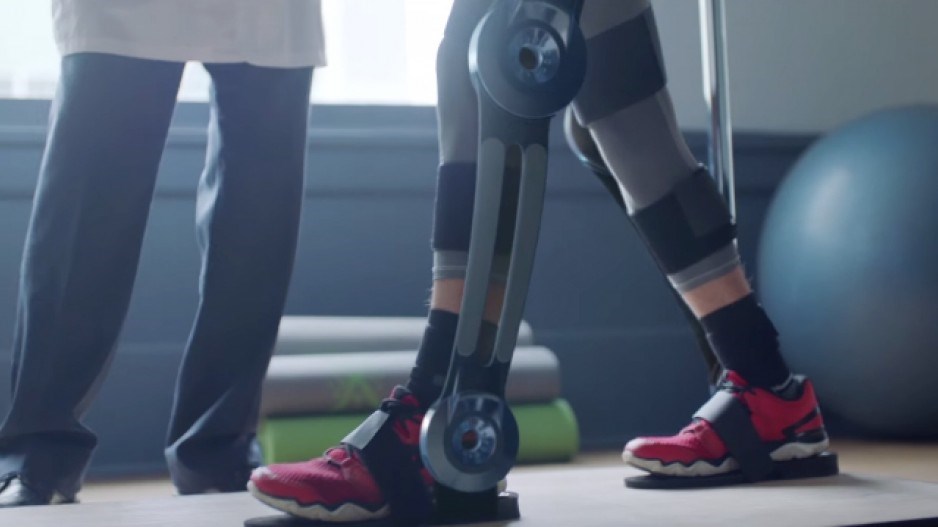A robotic exoskeleton is a ferocious fighting machine to many who were introduced to the concept in the 1986 sci-fi action film Aliens, in which the protagonist uses a giant apparatus to battle the titular antagonists.
But Mike Hilton hopes to soften the image of such devices with advances in robotics coming out of a B.C. research and development (R&D) firm.
“We want to see people walk again,” said the CEO of Genesis Robotics, an R&D company employing 60 specialists at its 20,000-square-foot-plus facility in Langley. “It’s one of the things that guides us in all of the work we do.”
The company has developed what it calls a LiveDrive actuator – the part of a robot that allows it to move.
Most actuators in robotics are relatively bulky electric motors, requiring a number of complex parts that can inflate the weight and the expense of the robot.
Genesis Robotics has spent three years researching how to make the LiveDrive actuator amplify magnetic forces and developing a structure that allows it to withstand extreme forces.
The result is a device that is half as expensive as conventional actuators, and lighter and safer to operate side by side with humans, according to the company.
The R&D firm, a spinoff from Genesis Advanced Technology, has raised $28 million in angel capital and is seeking out a commercialization partner.
Genesis Robotics has patented a number of reference designs, such as an exoskeleton that can assist people with disabilities, and walking robots that can help carry items for the elderly, to demonstrate to the industry what the LiveDrive is capable of.
“We have an aging population and we don’t have the younger population to care for them,” Hilton said. “We are going to need robotics in order to provide not just independent living for the elderly people in our society, but also just to support them in their final years.”
But he acknowledged the prospect of further automating the workforce is causing deep anxieties for many in Canada.
Hilton said the goal should be to facilitate a growing role of robotics and automation in the workforce “where we choose it to be.”
“There are many occupations today where we want to choose a robot to do that work because it’s dangerous, it’s not conducive to the human physiology,” he said, adding he envisions a movement of robots out of factories and into high-risk jobs in mining and forestry.
A 2016 report from the Brookfield Institute for Innovation + Entrepreneurship at Ryerson University estimated 42% of Canadian jobs were at high risk of being automated.
The most at-risk professions were retail salesperson, administrative assistant, food-counter attendant, cashier and transport truck driver. It is perhaps not surprising, then, that one of the applications for the LiveDrive is power steering that could be used for driverless vehicles.
Meanwhile, late last year, Generation R Consulting was commissioned to develop an artificial intelligence (AI) ethics guideline for new software that was automating tasks for workers at Technical Safety BC.
The consultancy based at the University of British Columbia billed the guideline as the first of its kind, as it identified ethical risks associated with its clients’ AI-powered software and recommended ways to mitigate those risks.
How much robotics impacts the Canadian workforce may rest on the specific jobs in question, such as those in the trucking industry.
A 2017 report from the C.D. Howe Institute concluded it was “very unlikely that employment in occupations highly susceptible to automation [35% of employment in Canada] will be completely replaced by smart machines over the next few years.”
The study, Future Shock? The Impact of Automation on Canada’s Labour Market, found most Canadian employment is concentrated in industries that have low risk of automation.
Industries where more than three-quarters of jobs are at high risk of automation account for 1.7% of the country’s employment (310,000 jobs).
But the potential for a robotic revolution has helped open the wallets of investors eyeing breakthroughs in B.C.
In addition to the $28 million in capital raised by Genesis Robotics, Vancouver-based Kindred AI has raised US$44 million to pursue research into using robots to automate tasks, such as sorting items for individual orders at e-commerce fulfilment centres.
“[This is] the easiest hard problem inside an industry to tackle,” Kindred AI co-founder Suzanne Gildert told Business in Vancouver last fall before she left the company in January to lead its spinoff, Sanctuary AI.
“But really the reason that we chose to commercialize is that we want to generate revenue to feed back into the mission of the company.”
The goal of Kindred AI, according to Gildert, is to build AI and robots that can think the same way the human brain does.
“I’m interested in robots that actually have more of a mind of their own,” she said.
Like the personal computer revolution that began in the 1980s, robots have the potential to change the way humans interact with technology, Hilton said.
He said that instead of wiping away jobs through automation, PCs gave way to the creation of different jobs. It’s a trajectory he predicts robotics will follow.
“Today, if I were to say to somebody, ‘We see a future where there is a robot in every business and every home,’ no one would think that’s a crazy idea. So I think we’re actually further ahead than where we were with personal computers in the 1980s.”




